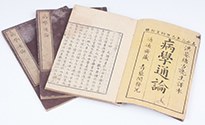About Tekijuku
What is Tekijuku?
The Tekijuku building, located in the business district in Kitahama, Chuo-ku, Osaka, is Japan’s only Edo period school building of Western learning still in existence. The building, designated as a National Historical Landmark and as a National Important Cultural Asset, is currently open to the public. Tekijuku was a private school of Western learning founded in 1838 by OGATA Koan (1810-1863), who was respected as a leading doctor of Western medicine. At Tekijuku, Western medical research was pursued, achieving a number of great medical accomplishments, including a vaccination program and treatment for cholera. Moreover, from the closing days of the Tokugawa shogunate to the Meiji Restoration, Tekijuku produced many distinguished individuals who contributed to the formation of Japan as a modern state. A record of signatures of Tekijuku students (Seimei roku) lists the names of 636 people who enrolled at the school in 1844 and later. If we add the numbers of non-resident students and those who did not leave their signatures, including those enrolled before 1843, the total number of Tekijuku students is estimated to have reached more than 1,000, according to historical sources. In addition to these students, it is believed that many other people sought instruction from Tekijuku.

In 1845, Koan purchased a large traditional townhouse in Kasho-machi, to which he moved Tekijuku from Kawara-machi. Much of the original school building still remains today. The name Tekijuku is derived from Koan’s pen name “Tekitekisai.” His school was thus called “Tekitekisai juku,” or “Tekiteki juku” and “Tekijuku” for short.
In Osaka in the later pre-modern period, ASADA Gouryu (1734-1799), TAKAHASHI Yoshitoki (1764-1804), HAZAMA Shigetomi (1756-1816), YAMAGATA Banto (1748-1821), NAKAI Riken (1732-1817), KOISHI Genshun (1743-1809), HASHIMOTO Sokichi (1764-1836), and NAKA Tenyu (1783-1835), who taught Koan, at his private school Shishisai juku, achieved progress in natural science-related studies, extending the frontiers of the fields of astronomy and medical science. It is said that another factor contributing to this scientific advancement was economic development and the resulting maturation of a merchant society, in which townspeople respected practicability, and embraced rationality.
Tekijuku was bordered on the west by the copper mint (Dōza), which was used as an accommodation for Philipp Franz von Siebold (1796-1866) and Dutch Factory employees. In addition, books written in Dutch were traded there. To the east of Tekijuku was the office for the collection of Nagasaki tawaramono (marine products exported from Nagasaki). Tekijuku was therefore in close cultural proximity with Nagasaki, which served as a gateway to advanced foreign cultures in the Edo Period. Under these circumstances, OGATA Koan not only achieved outstanding accomplishments as the best scholar and doctor at that time, but also served as a prominent educator who nurtured many talents, including FUKUZAWA Yukichi (1835-1901), HASHIMOTO Sanai (1834-1859), OMURA Masujirō (1824-1869), SANO Tsunetami (1823-1869), OTORI Keisuke (1832-1911), TAKAMATSU Ryoun (1836-1916), HANABUSA Yoshimoto (1842-1917), NAGAYO Sensai (1838-1902), IKEDA Kensai (1841-1918), and MITSUKURI Shuhei (1825-1886). Needless to say, in addition to the figures who took the lead in the Meiji Restoration, Tekijuku produced many graduates who returned to their hometowns where they became medical practitioners and contributed to community medicine and local vaccination programs. Tekijuku was in this sense, of historical significance in Japan’s modernization.


